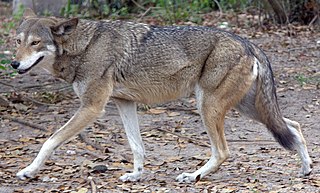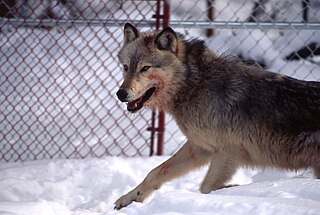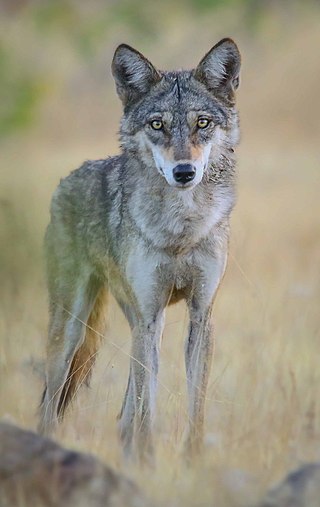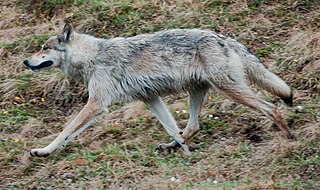
The red wolf is a canine native to the southeastern United States. Its size is intermediate between the coyote and gray wolf.

The wolf, also known as the gray wolf or grey wolf, is a canine native to Eurasia and North America. More than thirty subspecies of Canis lupus have been recognized, including the dog and dingo, though gray wolves, as popularly understood, only comprise naturally-occurring wild subspecies. The wolf is the largest wild extant member of the family Canidae, and is further distinguished from other Canis species by its less pointed ears and muzzle, as well as a shorter torso and a longer tail. The wolf is nonetheless related closely enough to smaller Canis species, such as the coyote and the golden jackal, to produce fertile hybrids with them. The wolf's fur is usually mottled white, brown, gray, and black, although subspecies in the arctic region may be nearly all white.

The dire wolf is an extinct canine. The dire wolf lived in the Americas during the Late Pleistocene and Early Holocene epochs. The species was named in 1858, four years after the first specimen had been found. Two subspecies are recognized: Aenocyon dirus guildayi and Aenocyon dirus dirus. The largest collection of its fossils has been obtained from the Rancho La Brea Tar Pits in Los Angeles.

Canis is a genus of the Caninae which includes multiple extant species, such as wolves, dogs, coyotes, and golden jackals. Species of this genus are distinguished by their moderate to large size, their massive, well-developed skulls and dentition, long legs, and comparatively short ears and tails.

A wolfdog is a canine produced by the mating of a domestic dog with a gray wolf, eastern wolf, red wolf, or Ethiopian wolf to produce a hybrid.

Lucyan David Mech, also known as Dave Mech, is an American biologist specializing in the study of wolves. He is a senior research scientist for the U.S. Geological Survey and an adjunct professor at the University of Minnesota. He has researched wolves since 1958 in locations including northern Minnesota, Isle Royale, Alaska, Yellowstone National Park, Ellesmere Island, and Italy.

The eastern wolf, also known as the timber wolf, Algonquin wolf and eastern timber wolf, is a canine of debated taxonomy native to the Great Lakes region and southeastern Canada. It is considered to be either a unique subspecies of gray wolf or red wolf or a separate species from both. Many studies have found the eastern wolf to be the product of ancient and recent genetic admixture between the gray wolf and the coyote, while other studies have found some or all populations of the eastern wolf, as well as coyotes, originally separated from a common ancestor with the wolf over 1 million years ago and that these populations of the eastern wolf may be the same species as or a closely related species to the red wolf of the Southeastern United States. Regardless of its status, it is regarded as unique and therefore worthy of conservation with Canada citing the population in eastern Canada as being the eastern wolf population subject to protection.

The Ethiopian wolf, also called the red jackal, the Simien jackal or Simien fox, is a canine native to the Ethiopian Highlands. In southeastern Ethiopia, it is also known as the horse jackal. It is similar to the coyote in size and build, and is distinguished by its long and narrow skull, and its red and white fur. Unlike most large canids, which are widespread, generalist feeders, the Ethiopian wolf is a highly specialised feeder of Afroalpine rodents with very specific habitat requirements. It is one of the world's rarest canids, and Africa's most endangered carnivore.

A pack hunter or social predator is a predatory animal which hunts its prey by working together with other members of its species. Normally animals hunting in this way are closely related, and with the exceptions of chimpanzees where only males normally hunt, all individuals in a family group contribute to hunting. When hunting cooperation is across two or more species, the broader term cooperative hunting is commonly used.

A pack is a social group of conspecific canines. The number of members in a pack and their social behavior varies from species to species. Social structure is very important in a pack. Canine packs are led by a breeding pair, consisting of the alpha male and alpha female.

The Mexican wolf, also known as the lobo mexicano is a subspecies of gray wolf native to eastern and southeastern Arizona and western and southern New Mexico and fragmented areas of northern Mexico. Historically, the subspecies ranged from eastern Southern California south into Baja California, east through the Sonora and Chihuahua Deserts and into West Texas.

The northwestern wolf, also known as the Mackenzie Valley wolf, Alaskan timber wolf, or Canadian timber wolf, is a subspecies of gray wolf in western North America. Arguably the largest gray wolf subspecies in the world, it ranges from Alaska, the upper Mackenzie River Valley; southward throughout the western Canadian provinces, aside from prairie landscapes in its southern portions, as well as the Northwestern United States.

Wolf reintroduction involves the reintroduction of a portion of grey wolves in areas where native wolves have been extirpated. More than 30 subspecies of Canis lupus have been recognized, and grey wolves, as colloquially understood, comprise nondomestic/feral subspecies. Reintroduction is only considered where large tracts of suitable wilderness still exist and where certain prey species are abundant enough to support a predetermined wolf population.

The Indian wolf is a subspecies of gray wolf that ranges from Southwest Asia to the Indian subcontinent. It is intermediate in size between the Himalayan wolf and the Arabian wolf, and lacks the former's luxuriant winter coat due to it living in warmer conditions. Within this subspecies, the "Indian plains wolf" is genetically basal to all other extant Canis lupus apart from the older-lineage Himalayan wolf, with both proposed as separate species. The Indian wolf travels in smaller packs and is less vocal than other variants of the gray wolf, and has a reputation for being cunning. The Indian wolf is one of the most endangered populations of gray wolf in the world.
Shaun Ellis is a British animal researcher who lived among wolves, and adopted a pack of abandoned North American timber wolf pups. He is the founder of Wolf Pack Management and is involved in a number of research projects in Poland and at Yellowstone National Park in the United States.

Erich Klinghammer was a wolf biologist best known for his contributions to the fields of ethology and behavioural ecology, particularly that of canids. He was the founder of Wolf Park in Indiana and a professor of animal behaviour at Purdue University.

The history of wolves in Yellowstone includes the extirpation, absence and reintroduction of wild populations of the gray wolf to Yellowstone National Park and the Greater Yellowstone Ecosystem. When the park was created in 1872, wolf populations were already in decline in Montana, Wyoming and Idaho. The creation of the national park did not provide protection for wolves or other predators, and government predator control programs in the first decades of the 1900s essentially helped eliminate the gray wolf from Yellowstone. The last wolves were killed in Yellowstone in 1926. After that, sporadic reports of wolves still occurred, but scientists confirmed in the mid-1900s that sustainable gray wolf populations had been extirpated and were absent from Yellowstone as well as 48 states.

California Wolf Center is a 501(c)(3) nonprofit located 50 miles east of San Diego, near the town of Julian, California. It is a conservation, education, and research center dedicated to wolf recovery in the wild. They are a statewide organization with staff and volunteers throughout California striving to pave the way for the return of wolves in California. Founded in 1977 to educate the public about wildlife and ecology, the center is currently home to several packs of gray wolves, some of which play an important role in educational programs. These wolves serve as ambassadors representing wolves in the wild. The center also hosts highly endangered Mexican gray wolves, now being reintroduced into the southwestern United States.

The Interior Alaskan wolf, also known as the Yukon wolf, is a subspecies of gray wolf native to parts of British Columbia, the Northwest Territories, Interior Alaska and Yukon.



















